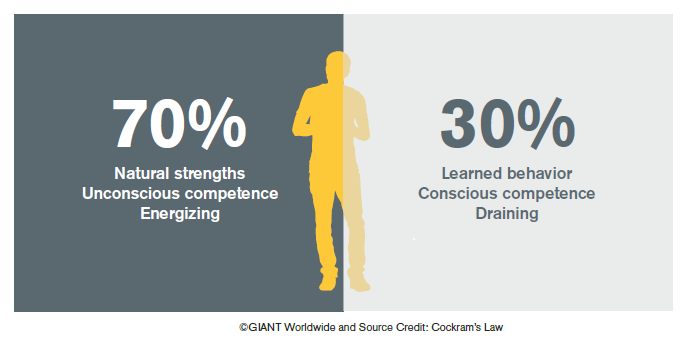
Taking a look back can help you plot a path forward on your career journey.
GPS is great, but it can’t tell you how to get where you want to go if it doesn’t know where you are. That same information is essential for making an intentional—not an accidental—career move.
Creating a Career Blueprint is a valuable exercise for setting future goals as well as understanding the path you’ve taken to arrive where you are now.
And we’re not just talking about your current company, position, and salary. We’re talking about how those things affect your satisfaction, your energy level, and your happiness.
Those factors are all in play when it comes to either identifying your next career move or evaluating your current situation to determine what you could or should change there before you decide to move on. To make that assessment, one of the tools we use is called the “70:30.” Here’s how it works:
Energizing or Draining
The concept behind the 70:30 principle is simple. In your work, you ideally want to spend 70% of your time doing tasks that come naturally to you. We call these your unconscious competencies. They are things that are so easy and enjoyable for you that you often do them without thinking. Plus, when you’re done with them, they leave you feeling energized and wanting to do more.
But no job is perfect, right? The other 30% of your work time is typically spent doing things that are more learned behaviors than natural abilities. We call these your conscious competencies. These require focus and effort, and you probably find you’re drained if you have to do too much of this type of work.
Like we said, no job is perfect, so it’s unrealistic to expect to spend 100% of your time on those more enjoyable unconscious competencies, nor would it be the best for your growth and development. But the closer you can get to a 70:30 split, the more engaged and fulfilled you’ll feel and the more your brain will be stretched and challenged in all the right ways.

Getting to Your 70:30 Balance
So, how do you find your perfect balance? The first step is to identify the type of tasks that fall into each category.
As you think about your past jobs or even volunteer roles, what responsibilities made you feel successful and energized? Which did you dread because they left you drained of energy and joy? How much of each task did you do each week?
You can use this information to craft your ideal mix of tasks and then use that list to evaluate your current role and consider new ones.
If you’re struggling to even come up with tasks that you love doing, that’s important too. That could be a sign that you need to rethink your career path. Even if you haven’t done them professionally, what type of responsibilities or roles would you add to your “70” list?
Once you have a good idea of what your 70:30 combination looks like, you can use that to figure out how you want to restructure your current job to delegate certain tasks and take on others or start a search for a completely new role.


